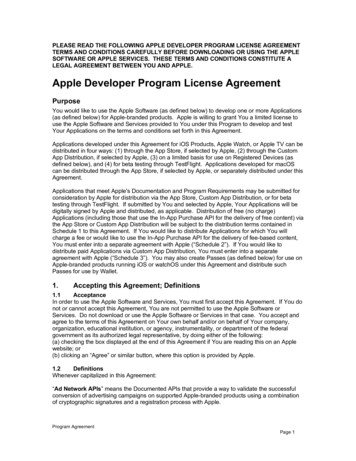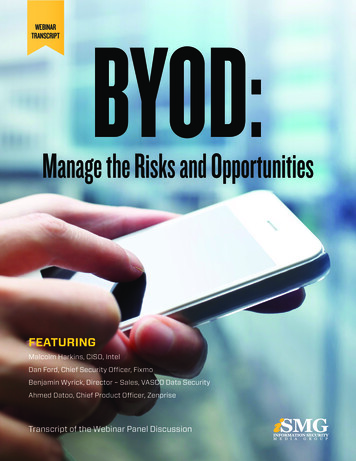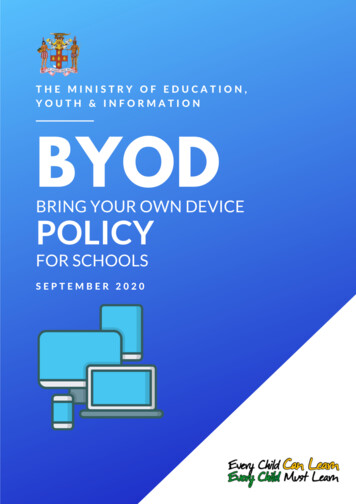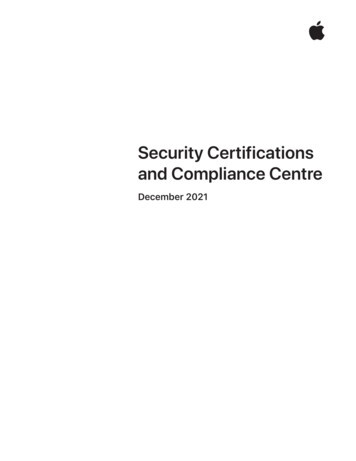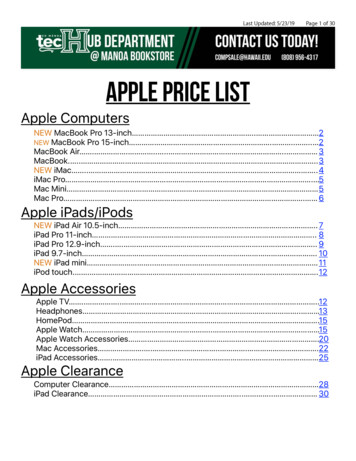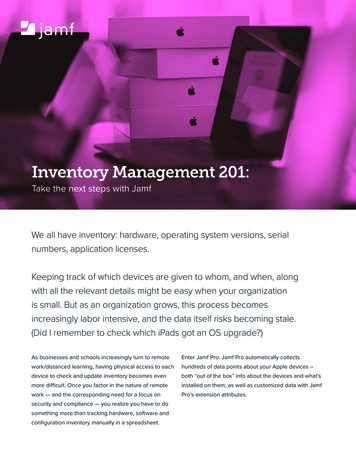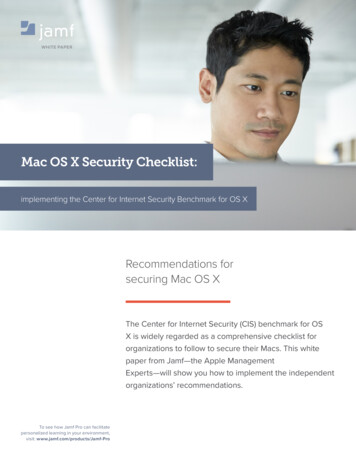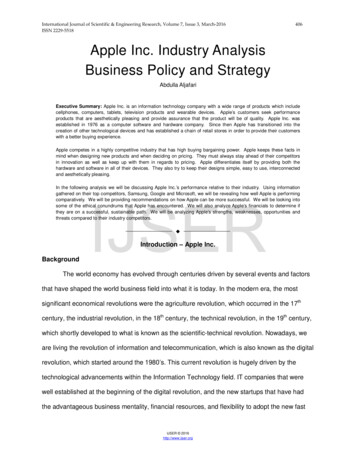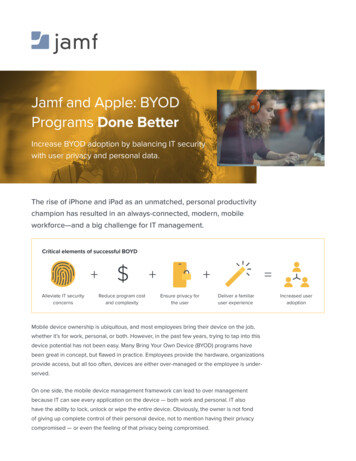
Transcription
Jamf and Apple: BYODPrograms Done BetterIncrease BYOD adoption by balancing IT securitywith user privacy and personal data.The rise of iPhone and iPad as an unmatched, personal productivitychampion has resulted in an always-connected, modern, mobileworkforce—and a big challenge for IT management.Critical elements of successful BOYD Alleviate IT securityconcerns Reduce program costand complexity Ensure privacy forthe user Deliver a familiaruser experienceMobile device ownership is ubiquitous, and most employees bring their device on the job,whether it’s for work, personal, or both. However, in the past few years, trying to tap into thisdevice potential has not been easy. Many Bring Your Own Device (BYOD) programs havebeen great in concept, but flawed in practice. Employees provide the hardware, organizationsprovide access, but all too often, devices are either over-managed or the employee is underserved.On one side, the mobile device management framework can lead to over managementbecause IT can see every application on the device — both work and personal. IT alsohave the ability to lock, unlock or wipe the entire device. Obviously, the owner is not fondof giving up complete control of their personal device, not to mention having their privacycompromised — or even the feeling of that privacy being compromised.Increased useradoption
Another method of managing BYOD devices is mobile application management, which allows IT to apply corporatepolicies to specific apps provisioned to the device. The problem is, IT is unable to provide other services like securelyconfiguring WiFi and VPN or requiring device passcodes and other security measures to confidently give employeescorporate access to the resources they need to do their job. The absence of basic corporate policies leaves theseemployees feeling under-served, and IT feeling open to security vulnerabilities.The reality is, the success — or failure — of a BYOD program hinges on both the comfort of the organization and theuser, which requires the right balance of IT control and securing devices with personal privacy. This paper outlines astrategy for striking that balance and making BYOD work.Privacy matters to usersOur personal devices carry the most private kinds ofdata: Personal correspondence, photos, contacts, anddocuments. Even the choice of apps installed on the devicecan reveal very private information about our hobbies,habits, and lifestyle. It’s no surprise that most employees areExample BYOD management controlsreluctant to give access to that information by enrolling theirpersonal device in a mobile device management (MDM)system controlled by their organization’s IT group.IT admins can:When BYOD programs fail, one common reason is users’ Lock the devicereluctance to volunteer access — or even the perceptionof access — to this personal data by an IT admin. Personalprivacy matters, and users are increasingly sensitive to anyattempt at breaching the privacy barrier in the name of ITcontrol.Security matters to ITFor the IT manager, the idea of unfettered access tointernal resources from personal devices with unknownconfiguration and security controls is the stuff of nightmares.Mobile devices are a common target for malware orphishing attacks, and present a potential vector for Apply corporate configurations, like Wi-Fi,VPN, mail, and passcode requirements Install and remove corporate apps and booksand the associated data Collect security info from the device Add/remove restrictions which protectcorporate dataIT admins cannot: Erase private data like photos, personal mail,or contacts Remove any personal appsintrusion when connected to an organization’s network. View any private data including the names ofWithout any visibility or control of the endpoints, effective Restrict the usage of the device or limit theIT security is an impossible task. The need for security ispersonal appspersonal apps that can be installedwhat pushes organizations to use MDM for their BYOD Track the location of the deviceprogram, and therefore require employees to enroll their Remove anything installed by the userpersonal device to gain access to the internal network, mail, Collect the user’s information from the devicecalendars, VPN and more.
Striking the balanceBoth users and IT have perfectly valid concerns. The employee only wants to use one device but doesn’t want to giveup access and control of their private data. IT wants to cut down costs by purchasing less corporate devices but stillneeds organizational security. For many organizations, these crossroads meant failure for their BYOD program.One solution to satisfying both concerns is to rethink the role of MDM as it applies to BYOD. Instead of a one-size-fitsall approach, IT managers can choose an MDM tool that’s designed for BYOD, with privacy protections to satisfy theemployee and strong security controls to satisfy the needs of IT.BYOD for the modern workforceLeading organizations choose a feature set built specifically for BYOD, to meet the needs of both sides but withoutunnecessary complexities and added costs. It’s important for both IT and the end user to clearly understandthe benefits of a BYOD program designed for them. It’s also critical to the success of the program to providecommunication and transparency to employees about the advantages of a BYOD program, as this will help easeany tension over using a personally owned device at work. Below are some examples of what the organization andemployees can gain from a well designed BYOD program.Success is when everyone winsEmployee benefitsOrganizational benefitsA familiar experience, both personal andA balance between security and end userprofessional, all in one device:privacy, all in one device: Transparency of IT management capabilities Ensure security of the device and accessfor a personally owned device, beforeto corporate data and resources, keepingenrolling, that ensures protection of theemployees protected and productive.user’s personal data. Secure access to corporate resources suchas email, calendars, Wi-Fi and apps, making iteasy to be productive. Reduction in cost by purchasing fewerdevices
BYOD with Jamf and AppleAs this paper stresses, the goal is to hit a sweet spot for personal devices that doesn’t over manage but still allows ITto adequately serve their users and organization through easy, secure access to the software and apps users needfor their job. It’s with this in mind that Jamf has leveraged Apple to extend the benefits and enhance what is possiblefor Bring Your Own Device programs.With a heavy focus on security and privacy, Apple’s Account-Driven User Enrollment is a BYOD method for iOS andiPadOS devices that streamlines the user enrollment onboarding process and focuses on providing corporate accessto BYO users while maintaining user privacy on their personal device. Organizations can take advantage of this newworkflow to enroll personally owned mobile devices with iOS and iPadOS 15 or later with Jamf Pro 10.33 or later.Account-Driven User Enrollment keeps personal and institutional data separate by associating a personal Apple IDwith personal data and a Managed Apple ID with corporate data. Jamf Pro has embraced Apple’s Service Discoveryfeature, allowing for use of a set of configurations that associate management with the employee and how they usethe device for work, not the entire device itself. The user has the ability to access their corporate data in a securemanner without IT ever having to touch the device or send them an enrollment link. The employee even receivesJamf Self Service which can be used to install corporate applications. And all the user needs to do is somethingsimple and similar to what they’ve done many times before on their personal device which is to go into generalsettings. It’s a familiar and trusted experience that makes it easy for the user and a bit like zero-touch deployment forIT with the perks of secure access to their organizations resources.
Here’s How it Works1The user authenticates to thedevice using a Managed Apple IDby navigating to Settings General VPN & Device Managementand then signs into their Work orSchool Account with their ManagedApple ID. After the user enters theManaged Apple ID, they must tapContinue.2The enrollment portal displaysand prompts the user to entertheir Jamf Pro User Account ordirectory credentials (for example,LDAP or Azure AD). After enteringcredentials, the user must tapLogin. The user must then sign intoiCloud with their Managed Apple IDemail address and password whenprompted.
3The user is prompted to allowremote management and the MDMProfile downloads to the device.And that’s it! It’s a consumer-simpleexperience for the end user whilealso enterprise-secure for theorganization.Add another layer of protectionPrivate Relay is a new iCloud service that protects an individual’s privacy by hiding their IP address and location fromthe websites they visit. The introduction of Private Relay follows the launch of Jamf Private Access, Jamf’s solution toenable secure access to business applications without the performance, privacy and security challenges of legacyenterprise VPN connections. Now with Private Relay and Jamf Private Access, users are protected in their privateand enterprise browsing. Personally-owned devices can be deployed with Jamf to protect and route enterprise traffic;personal browsing will remain private by being routed via Private Relay.Private Relay and Jamf Private Access work together to ensure employees are enterprise secure, their privacy isprotected and when running both Jamf Private Access and iCloud Private Relay together, it is an optimal approach toprivacy and security without compromising performance.ConclusionA successful BYOD program is a benefit to employees and IT admins alike. With the right MDMsolution, IT can concentrate on addressing critical enterprise needs without friction from thetechnology itself or users. And users receive comfort and familiarity with their own devicewithout intrusive IT involvement.Learn more about BYOD user enrollment or see how Jamf with Apple can bring your BYOD plansto life by Requesting a Trial.
One solution to satisfying both concerns is to rethink the role of MDM as it applies to BYOD. Instead of a one-size-fits-all approach, IT managers can choose an MDM tool that's designed for BYOD, with privacy protections to satisfy the employee and strong security controls to satisfy the needs of IT. BYOD for the modern workforce

